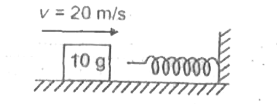A 2 kg block slides on a horizontal floor with a speed of 4 m/s. It strikes an uncompressed spring, and compresses it till the block is motionless. The kinetic friction force is 15 N and spring constant is 10000 N/m. The spring is compressed by (in cm):
2.5
The correct Answer is:D
To solve the problem, we will use the work-energy principle, which states that the work done on an object is equal to the change in its kinetic energy. In this case, we will consider the work done by the spring force and the work done by friction.
1. Identify the Given Values:
- Mass of the block, m=2kg
- Initial speed of the block, v=4m/s
- Kinetic friction force, Ff=15N
- Spring constant, k=10000N/m
2. Calculate the Initial Kinetic Energy:
The initial kinetic energy (KEi) of the block can be calculated using the formula:
KEi=12mv2
Substituting the values:
KEi=12×2kg×(4m/s)2=12×2×16=16J
3. Set Up the Work-Energy Equation:
The work done by the friction force and the spring force will equal the change in kinetic energy. Since the block comes to rest, the final kinetic energy (KEf) is 0. Thus, we have:
Wf+Ws=KEf−KEi
Where:
- Wf is the work done by friction, which is negative because it opposes the motion: Wf=−Ff⋅x=−15⋅x
- Ws is the work done by the spring, which is also negative: Ws=−12kx2=−12⋅10000⋅x2
Therefore, the equation becomes:
−15x−12⋅10000⋅x2=0−16
Simplifying gives:
−15x−5000x2=−16
Rearranging the equation:
5000x2+15x−16=0
4. Solve the Quadratic Equation:
We can use the quadratic formula x=−b±√b2−4ac2a where a=5000,b=15,c=−16.
x=−15±√152−4⋅5000⋅(−16)2⋅5000
Calculate the discriminant:
152=225
4⋅5000⋅16=320000
b2−4ac=225+320000=320225
Now substituting back into the formula:
x=−15±√32022510000
Calculate √320225:
√320225≈565.8
Therefore:
x=−15±565.810000
5. Calculate the Positive Root:
Taking the positive root:
x=−15+565.810000=550.810000=0.05508m
Convert to centimeters:
x=0.05508×100=5.508cm≈5.5cm
Final Answer:
The spring is compressed by approximately 5.5 cm.
- Mass of the block, m=2kg
- Initial speed of the block, v=4m/s
- Kinetic friction force, Ff=15N
- Spring constant, k=10000N/m
The initial kinetic energy (KEi) of the block can be calculated using the formula:
KEi=12mv2
Substituting the values:
KEi=12×2kg×(4m/s)2=12×2×16=16J
The work done by the friction force and the spring force will equal the change in kinetic energy. Since the block comes to rest, the final kinetic energy (KEf) is 0. Thus, we have:
Wf+Ws=KEf−KEi
Where:
- Wf is the work done by friction, which is negative because it opposes the motion: Wf=−Ff⋅x=−15⋅x
- Ws is the work done by the spring, which is also negative: Ws=−12kx2=−12⋅10000⋅x2
−15x−12⋅10000⋅x2=0−16
Simplifying gives:
−15x−5000x2=−16
Rearranging the equation:
5000x2+15x−16=0
We can use the quadratic formula x=−b±√b2−4ac2a where a=5000,b=15,c=−16.
x=−15±√152−4⋅5000⋅(−16)2⋅5000
Calculate the discriminant:
152=225
4⋅5000⋅16=320000
b2−4ac=225+320000=320225
Now substituting back into the formula:
x=−15±√32022510000
Calculate √320225:
√320225≈565.8
Therefore:
x=−15±565.810000
Taking the positive root:
x=−15+565.810000=550.810000=0.05508m
Convert to centimeters:
x=0.05508×100=5.508cm≈5.5cm
The spring is compressed by approximately 5.5 cm.
Similar Questions
A 16kg block moving on a frictionless horizontal surface with a velocity of 4m/s compresses an ideal spring and comes to rest. If the force constant of the spring be 100N/m, then how much is the spring commpressed ?
View SolutionEach of the blocks shown in figure has mass 1 kg. The rear block moves with a speed of 2 m/s towards the front block kept at rest. The spring attached to the front block islight and has a spring constant 50 N/m. find the maximum compression of the spring.

View Solution
Knowledge Check
A 2kg block slides on a horizontal floor with the a speed of 4m/s it strikes a uncompressed spring , and compresses it till the block is motionless . The kinetic friction force is compresses is 15N and spring constant is 10000N/m . The spring by
A8.5cmB5.5cmC2.5cmD11.0cmA block of mass 4kg slides on a horizontal frictionless surface with a speed of 2m/s. It is brought to rest in compressing a spring in its path. If the force constant of the spring is 400N/m, by how much the spring will be compressed
A2×10−2mB0.2mC20mD200mA block of mass m is initially moving to the right on a horizontal frictionless surface at a speed v. It then compresses a spring of spring constant k. At the instant when the kinetic energy of the block is equal to the potential energy of the spring, the spring is compressed a distance of :
Av√m/2kBv√m/kCv√m/4kDmv2/4k
A block of mass m moving at a speed v compresses as spring thrugh a distance x before its speed is halved. Find the spring constant of the spring.
View SolutionA block of mass m moving at a speed v compresses a spring throgh a distance x before its speed is halved. Find the spring constant of the spring.
View SolutionA block of mass 5.7kg slides on a horizontal frictionless table with a constant speed of 1.2ms−1. It is brougth momentarily to rest by compressing a spring in its path. By what maximum distance is the spring compressed ? The spring constant k=1500Nm−1.
View SolutionA block of 10 g slides on smooth horizontal surface with 20 m/s towards a spring of spring constant 100 N/m placed horizontally (as shown in figure). The maximum compression in spring is

View SolutionA solid sphere of mass 2 kg is rolling on a frictional horizontal surface with velocity 6 m/s. It collides on the free end of an ideal spring whose other end in fixed. The maximum compression produced in the spring will be (Force constant of the spring is 36 N/m).
View Solution
